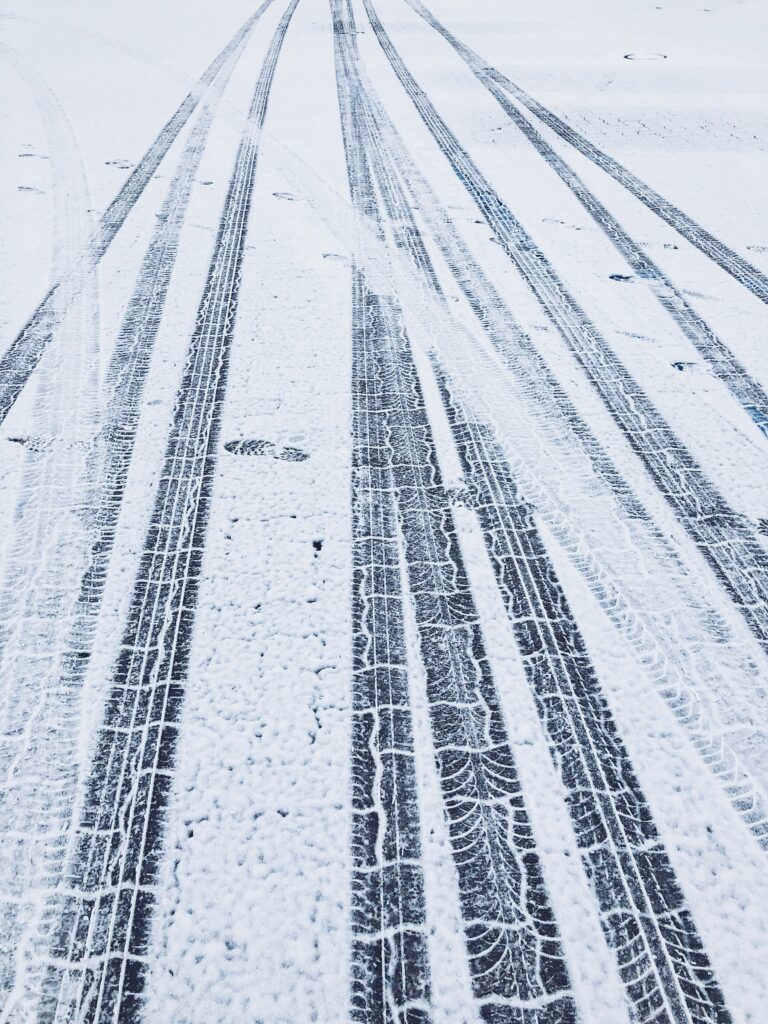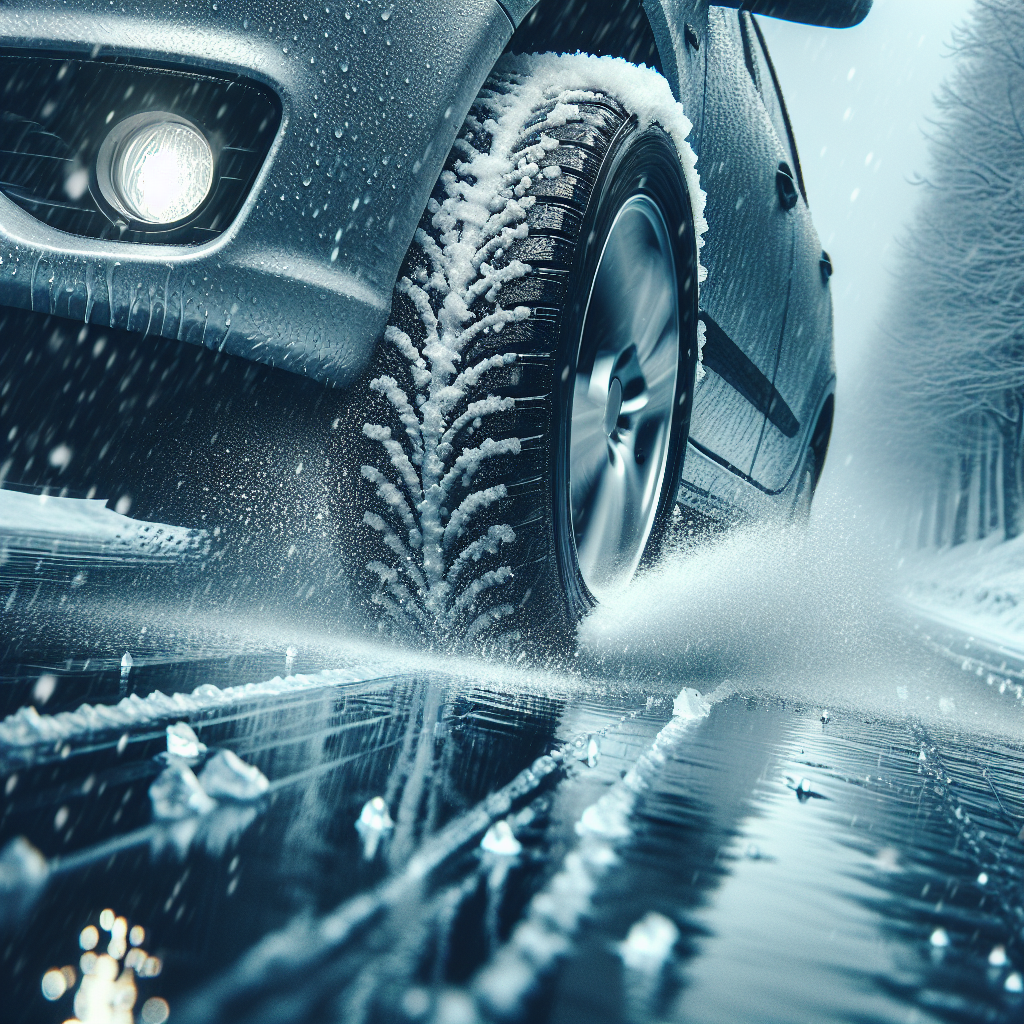Imagine driving on a rainy winter day, with water pooling on the roads and your tires struggling to find traction. The risk of hydroplaning, where your tires lose contact with the road surface and you lose control of your vehicle, becomes a real concern. But what if there was a simple way to reduce this risk and ensure a safer driving experience? In this article, we will explore the effectiveness of Winter tires in reducing the risk of hydroplaning on wet winter roads. Discover how these specialized tires can make all the difference in keeping you safe and confident during the most challenging winter conditions.
Understanding Hydroplaning
Hydroplaning occurs when your vehicle loses traction and skids on a wet surface, such as a wet winter road. This happens when a layer of water builds up between the tires and the road, preventing the tires from maintaining a solid grip. As a result, you may feel a loss of control over your vehicle, leading to potentially dangerous situations.
Factors that Contribute to Hydroplaning
Several factors contribute to the occurrence of hydroplaning. The speed at which you are driving plays a significant role, as higher speeds increase the chances of hydroplaning. The tread depth and condition of your tires also affect hydroplaning risk. Bald or worn-out tires have less traction and are more prone to hydroplaning. Additionally, the volume of water on the road and the tire’s contact with it determine the likelihood of hydroplaning. The more water present and the less tread your tires have, the greater the risk of hydroplaning.
Dangers of Hydroplaning on Wet Winter Roads
Hydroplaning on wet winter roads can be particularly dangerous. Winter roads are often covered in rain, snow, and slush, adding to the already hazardous condition. Reduced visibility, icy patches, and uneven surfaces further increase the risk of hydroplaning. When hydroplaning occurs in winter conditions, it becomes more challenging to regain control of your vehicle due to the unpredictable nature of the road surface. This can lead to accidents, injuries, and even fatalities.
Importance of Reducing Hydroplaning Risk
Reducing hydroplaning risk is crucial for your safety and the safety of others on the road. By minimizing the chances of hydroplaning, you can maintain control over your vehicle and react effectively in unexpected situations. Installing the right tires and taking necessary precautions can significantly reduce the risk of hydroplaning on wet winter roads, allowing you to enjoy a safer and more confident driving experience.
Winter Tires and Their Features
Winter tires are specifically designed to provide enhanced performance and safety on winter roads. These tires offer unique features that make them suitable for driving in cold, snowy, and wet conditions. Unlike all-season or summer tires, winter tires are optimized for lower temperatures, providing better grip and traction on slippery surfaces.

Key Features of Winter Tires
Winter tires come with several key features that enhance their performance in winter conditions. One of the primary features is the tire tread pattern, specifically designed to channel water, snow, and slush away from the tire’s contact patch. This helps maintain grip and reduce the risk of hydroplaning. Moreover, winter tires are made of a special compound that remains flexible even in extremely cold temperatures, ensuring better traction and control.
Tire Tread Patterns for Enhanced Traction
The tread pattern of winter tires plays a vital role in improving traction on wet winter roads. These tires typically have more aggressive, deeper, and wider grooves compared to all-season or summer tires. These deep grooves help expel water, slush, and snow, allowing the tire to maintain better contact with the road surface. Additionally, some winter tires feature different block shapes and sipes, which further enhance traction by providing more biting edges.
Siping Technology for Improved Grip
Siping refers to the tiny slits or cuts added to the tire tread blocks. These sipes are strategically placed to enhance grip on wet and slippery surfaces. When pressure is applied to the tire, the sipes open up, creating additional edges that grip the road. This siping technology improves traction, reduces the risk of hydroplaning, and enhances overall handling on wet winter roads.
Benefits of Using Winter Tires
Using winter tires offers numerous benefits, especially in wet winter conditions. These tires drastically improve grip and traction, providing better control while driving on slippery roads. They allow for shorter braking distances, reducing the chances of accidents. Additionally, winter tires offer improved cornering stability and better handling, enhancing overall safety. Investing in winter tires can provide you with the peace of mind you need to confidently navigate through challenging winter road conditions.
Tire Tread and Hydroplaning Resistance
The tire tread plays a crucial role in preventing hydroplaning. The tread pattern effectively disperses water from the tire’s contact patch, enabling the tire to maintain better traction on wet surfaces. Tires with deeper and wider grooves have a higher capacity to channel water away, reducing the risk of hydroplaning. It is essential to ensure that your tires have sufficient tread depth, especially during the winter season when road conditions are more challenging.

Different Tread Patterns and Their Impact on Hydroplaning
Various tread patterns are available for winter tires, each offering different performance characteristics. Some tread patterns have larger blocks and wider grooves, ideal for deep snow and slush conditions. These tires excel in providing excellent grip and traction. Other tread patterns feature a high density of sipes, maximizing the number of biting edges and enhancing grip on icy surfaces. The choice of tread pattern depends on the specific winter conditions you’re likely to encounter in your area.
Importance of Good Tire Tread Depth on Wet Winter Roads
Good tire tread depth is essential for maintaining traction on wet winter roads. As tires wear down over time, the depth of the grooves decreases, reducing the tire’s ability to channel water away. This increases the risk of hydroplaning. It is recommended to regularly check your tire tread depth and replace your tires when they reach the minimum tread depth specified by the manufacturer. This will ensure optimal performance and safety, especially when driving on wet winter roads.
Effectiveness of Winter Tires in Reducing Hydroplaning
Winter tires significantly reduce the risk of hydroplaning on wet winter roads. Their specialized tread patterns and compounds are specifically designed to provide better traction and grip in cold, wet conditions. By effectively channeling water away from the tire’s contact patch, winter tires help maintain better contact with the road, reducing the chances of hydroplaning. Investing in winter tires is a proactive step to ensure your safety and minimize the risks associated with driving in winter weather.
Winter Tire Compounds and Wet Road Performance
Winter tire compounds are specially formulated to perform optimally in cold, wet conditions. These compounds contain higher levels of natural rubber and silica, which allow the tire to remain flexible even when temperatures drop significantly. This flexibility enhances grip and traction on wet surfaces. The silica in the compound also enhances the tire’s ability to adhere to the road, providing improved braking performance.
Ability to Remain Flexible in Low Temperatures
One of the significant advantages of winter tire compounds is their ability to remain flexible in low temperatures. When the temperature drops below freezing, all-season or summer tires can become stiff, resulting in reduced grip and traction. Winter tires, on the other hand, retain their flexibility, ensuring that the tire remains in close contact with the road surface. This flexibility greatly reduces the risk of hydroplaning on wet winter roads.

Enhanced Grip on Wet Surfaces
Winter tire compounds are designed to excel in wet conditions. The higher levels of natural rubber and silica in the compound improve grip on wet surfaces. This enhanced grip allows for better acceleration, shorter braking distances, and improved overall handling on wet winter roads. Regardless of the amount of water on the road, winter tires remain effective in maintaining better control over your vehicle.
Comparison with All-Season and Summer Tires
When it comes to wet road performance, winter tires outperform all-season and summer tires. All-season tires may provide reasonable performance in mild winter conditions, but they cannot match the traction and grip offered by winter tires on wet winter roads. Summer tires, designed for warm weather, struggle significantly in wet and cold conditions, increasing the risk of hydroplaning. Winter tires are specifically engineered to excel in the challenging conditions of winter, making them the safest choice for wet winter roads.
Enhanced Traction Technologies in Winter Tires
Winter tires utilize various traction technologies to further enhance their performance in wet winter conditions. These technologies include the use of silica in tire compounds and the option of studded or studless tire designs.
Introduction to Traction Technologies
Traction technologies incorporated in winter tires aim to improve grip and traction on slippery surfaces. These technologies enhance the tire’s ability to maintain contact with the road, reducing the likelihood of hydroplaning and enhancing overall safety.
Use of Silica in Tire Compounds
The inclusion of silica in winter tire compounds significantly enhances wet road performance. Silica improves the tire’s ability to adhere to the road surface, delivering better grip and traction. It allows for shorter braking distances and improved acceleration on wet winter roads.

Winter Tire Technologies: Studs and Studless
Two main types of winter tire technologies include studded and studless designs. Studded tires feature metal studs inserted into the tire tread, providing additional grip on ice and packed snow. Studless winter tires, on the other hand, rely on advanced tread designs and compounds to deliver enhanced performance without the use of studs.
Benefits and Limitations of Studded Tires
Studded tires offer excellent grip on icy surfaces, making them a popular choice in regions with severe ice and snow conditions. The metal studs significantly increase traction and reduce the risk of skidding on icy roads. However, studded tires have some limitations. They perform less effectively on dry or wet pavement, are noisier, and may cause damage to road surfaces. Additionally, some jurisdictions have restrictions on the use of studded tires due to these concerns.
Effectiveness of Studless Winter Tires in Reducing Hydroplaning
Studless winter tires have become increasingly popular due to their excellent performance on wet winter roads. The advanced tread designs and compound formulations of studless tires excel in providing traction and grip in cold and wet conditions. These tires effectively reduce the risk of hydroplaning, providing a safe and reliable driving experience on wet winter roads.
Improved Braking and Acceleration Performance
One of the key benefits of using winter tires is the improvement in braking and acceleration performance. Winter tires have a shorter stopping distance on wet winter roads compared to all-season or summer tires. Their superior grip allows for better traction when accelerating, increasing your ability to maneuver safely in adverse conditions.
Impact of Winter Tire Installation on Vehicle Handling
Installing winter tires can have a significant impact on your vehicle’s handling in wet winter conditions. The improved grip and traction provided by winter tires allow for better control during cornering and maneuvering. The enhanced handling reduces the risks associated with sudden turns or lane changes, providing a safer driving experience.

Tips for Safe Driving with Winter Tires
While winter tires improve safety on wet winter roads, it is essential to adopt safe driving practices. Maintain a safe speed suitable for the road conditions, and avoid sudden acceleration or braking. Keep a safe distance from the vehicle ahead to allow for greater stopping distances. Furthermore, reduce the risk of hydroplaning by avoiding standing water and adjusting your driving style accordingly.
Proper Tire Pressure and Maintenance
Proper tire pressure is crucial for optimal performance, including reducing the risk of hydroplaning. Cold weather can cause tires to lose air pressure, so it is essential to regularly check and maintain the recommended tire pressure. Additionally, ensure proper tire maintenance by periodically inspecting the tread depth, looking for signs of wear or damage, and rotating the tires as recommended by the manufacturer.
Impact of Winter Tire Use on Fuel Efficiency
Winter tires can have a slight impact on fuel efficiency. Their specialized compound and tread patterns may contribute to a slight increase in rolling resistance, resulting in a small decrease in fuel economy. However, the effect is relatively minimal and outweighed by the significant safety benefits provided by winter tires in wet winter conditions.
Environmental Concerns of Studded Tires
Studded tires raise environmental concerns due to their potential damage to road surfaces. The metal studs can wear down road pavement, increasing the need for repairs and maintenance. Moreover, the small metal particles shed by studded tires can contribute to air and water pollution. These environmental considerations have led some jurisdictions to restrict or regulate the use of studded tires.
Studless Winter Tires as an Eco-Friendly Alternative
Studless winter tires offer an eco-friendly alternative to studded tires. Without the use of metal studs, these tires do not contribute to the same level of road damage or release metal particles into the environment. Studless tires are a sustainable choice that provides excellent performance on wet winter roads without compromising safety or the environment.
Choosing the Right Winter Tires
When selecting winter tires, it is essential to understand tire markings and codes to make an informed decision. Tire markings provide valuable information about the tire’s size, load capacity, traction rating, and speed rating. By understanding these markings, you can ensure that you choose the right winter tires for your vehicle and the specific winter conditions you’re likely to encounter.
Considerations when Selecting Winter Tires
Several factors should be considered when selecting winter tires. The climate and specific winter conditions in your area play a significant role in determining the appropriate tire type and features. Additionally, the size, load capacity, and speed rating should match your vehicle’s specifications. Understanding your driving needs and selecting tires that meet those requirements is vital to ensuring optimal performance and safety.
Optimal Tire Size and Load Capacity for Your Vehicle
Choosing the right tire size and load capacity for your vehicle is essential. You can find this information in your vehicle’s owner’s manual or on the sidewall of your tires. It is crucial to select tires that match the specifications provided by the manufacturer to ensure proper fitment and performance. Overloading or using tires with incorrect load capacity can lead to handling issues and increased hydroplaning risk.
Budget-Friendly Options without Compromising Safety
While investing in high-quality winter tires is recommended, there are budget-friendly options available that still prioritize safety. Many reputable tire manufacturers offer affordable winter tire options that provide adequate grip and traction for wet winter conditions. Choosing tires from trusted brands and consulting with tire experts can help you find cost-effective options without compromising on safety.
Legal Obligations to Use Winter Tires
In many regions, there are legal obligations to use winter tires during specific periods or in certain weather conditions. These obligations are in place to ensure the safety of drivers and prevent accidents on wet winter roads. Understanding the legal requirements in your region is crucial to avoid potential fines or legal consequences.
Applicable Laws and Regulations in Different Regions
The laws and regulations regarding winter tire use vary across different regions. Some areas mandate the use of winter tires during specific months, while others require them when specific weather conditions are present. It is essential to familiarize yourself with the local laws and regulations to ensure compliance and maintain safety on wet winter roads.
Consequences of Not Using Winter Tires when Required
Failing to use winter tires when required can have severe consequences. Apart from potential legal penalties, not using winter tires increases the risk of accidents and injuries. In the event of an accident, insurance claims may also be affected if it is found that winter tires were not installed when legally required. It is always better to prioritize safety and use winter tires to reduce the risk of hydroplaning and ensure a safe driving experience in wet winter conditions.
Conclusion
Hydroplaning on wet winter roads is a serious concern for drivers. However, by understanding the risks and taking appropriate precautions, you can significantly reduce the probability of hydroplaning. Installing winter tires with the right tread patterns, compounds, and traction technologies is one of the most effective ways to enhance grip and traction on wet winter roads. With better control over your vehicle, you can confidently navigate through challenging winter conditions, ensuring your safety and the safety of those around you. Remember to stay informed about local regulations, properly maintain your tires, and adopt safe driving practices to make the most of your winter tires and enjoy a worry-free driving experience.

